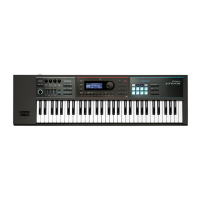53
MFX/Chorus/Reverb Parameters
54: ANALOG LONG DELAY
A delay in which the delay time can be varied smoothly, and allowing an extended
delay to be produced.
L out
2-Band
EQ
Balance W
Balance W
Balance D
EQ
Feedback
Time Control Delay
Parameter Value Explanation
Delay Time # 0–2600[msec], note Adjusts the time until the delay is heard.
Acceleration 0–15
Adjusts the speed which the Delay Time changes
from the current setting to a specied new
setting.
The rate of change for the Delay Time directly
aects the rate of pitch change.
Feedback # -98–+98[%]
Adjusts the amount of the delay that’s fed back
into the eect. Negative (-) settings invert the
phase.
HF Damp
200–8000[Hz],
BYPASS
Adjusts the frequency above which sound fed
back to the eect is ltered out. If you do not
want to lter out any high frequencies, set this
parameter to BYPASS.
Pan # L64–63R Stereo location of the delay
Low Gain -15–+15[dB] Gain of the low range
High Gain -15–+15[dB] Gain of the high range
Balance # D100:0W–D0:100W
Volume balance between the direct sound (D)
and the delay sound (W)
Level 0–127 Output level
55: TAPE ECHO
A virtual tape echo that produces a realistic tape delay sound. This simulates the
tape echo section of a Roland RE-201 Space Echo.
Echo Level
Echo Level
Tape Echo
Direct Level
Parameter Value Explanation
Mode
S, M, L, S+M, S+L,
M+L, S+M+L
Combination of playback heads to use
Select from three dierent heads with dierent
delay times.
S: short, M: middle, L: long
Repeat Rate # 0–127
Tape speed
Increasing this value will shorten the spacing of
the delayed sounds.
Intensity # 0–127 Amount of delay repeats
Bass -15–+15[dB] Boost/cut for the lower range of the echo sound
Treble -15–+15[dB] Boost/cut for the upper range of the echo sound
Head S Pan
L64–63R
Independent panning for the short, middle, and
long playback heads
Head M Pan
Head L Pan
Tape Distortion 0–5
Amount of tape-dependent distortion to be
added
This simulates the slight tonal changes that can be
detected by signal-analysis equipment. Increasing
this value will increase the distortion.
Wow/Flutter Rate 0–127
Speed of wow/utter (complex variation in pitch
caused by tape wear and rotational irregularity)
Wow/Flutter Depth 0–127 Depth of wow/utter
Echo Level # 0–127 Volume of the echo sound
Direct Level # 0–127 Volume of the original sound
Level 0–127 Output level
56: LOFI NOISE
In addition to a lo- eect, this adds various types of noise such as white noise and
disc noise.
L out
Lo-Fi
Lo-Fi
Noise Gen.
EQ
2-Band
Parameter Value Explanation
LoFi Type 1–9
Degrades the sound quality. The sound quality
grows poorer as this value is increased.
Post Filter Type
Type of lter that follows the LoFi eect
OFF No lter is used
LPF Cuts the frequency range above the Cuto.
HPF Cuts the frequency range below the Cuto.
Post Filter Cuto 200–8000[Hz] Center frequency of the lter
W/P Noise Type WHITE, PINK Switch between white noise and pink noise.
W/P Noise LPF
200–8000[Hz],
BYPASS
Center frequency of the low pass lter applied to
the white/pink noise (BYPASS: no cut)
W/P Noise Level # 0–127 Volume of the white/pink noise
Disc Noise Type LP, EP, SP, RND
Type of record noise
The frequency at which the noise is heard
depends on the selected type.
Disc Noise LPF
200–8000[Hz],
BYPASS
Adjusts the cuto frequency of the low pass lter
applied to the record noise. If you don’t want to
lter out any high frequencies, set this parameter
to BYPASS.
Disc Noise Level # 0–127 Volume of the record noise
Hum Noise Type 50, 60[Hz] Frequency of the hum noise
Hum Noise LPF
200–8000[Hz],
BYPASS
Center frequency of the low pass lter applied to
the hum noise (BYPASS: no cut)
Hum Noise Level # 0–127 Volume of the hum noise
Low Gain -15–+15[dB] Gain of the low range
High Gain -15–+15[dB] Gain of the high range
Balance # D100:0W–D0:100W
Volume balance between the direct sound (D)
and the eect sound (W)
Level 0–127 Output level
57: LOFI COMPRESS
This is an eect that intentionally degrades the sound quality for creative purposes.
L out
Compressor
Lo-Fi
Lo-Fi
Compressor
EQ
2-Band
Parameter Value Explanation
Pre Filter Type
Selects the type of lter applied to the sound before it passes through
the Lo-Fi eect.
1 Compressor o
2–6 Compressor on
LoFi Type 1–9
Degrades the sound quality. The sound quality
grows poorer as this value is increased.
Post Filter Type
Type of lter
OFF No lter is used
LPF Cuts the frequency range above the Cuto
HPF Cuts the frequency range below the Cuto
Post Filter Cuto 200–8000[Hz] Basic frequency of the Post Filter
Low Gain -15–+15[dB] Gain of the low range
High Gain -15–+15[dB] Gain of the high range
Balance # D100:0W–D0:100W
Volume balance between the direct sound (D)
and the eect sound (W)
Level # 0–127 Output level
3
3
3
3

